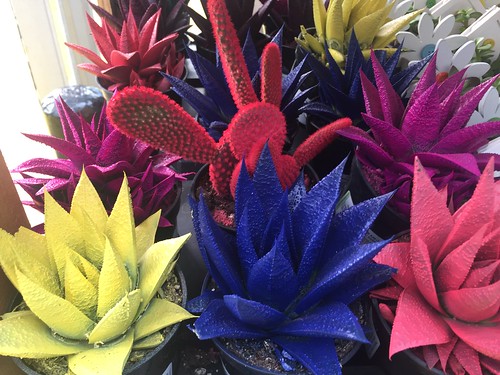Resource Library
Plant of the Week: Colorful Cacti and Succulents
Opinions, as they say, are like… let’s say, bellybuttons: everyone has one. On walks through my favorite big box home centers over the past couple years I’ve spotted — and been repulsed by — the brightly colored cacti and succulents sold under the trademarked name of Kosmik Kactus.
For the most part these plants are common, fast growing species of Haworthias (succulents) and Opuntias and Mammillaria (cacti) that have been painted various bright colored shades of blue, pink, red, yellow and even green. The tag line for the display reads, “Boldly going where no plants have gone before.” Boy, they got that right. My initial repulsion was at two levels: aesthetic and emotional. Aesthetically, I thought, who in their right mind would want these gaudy abominations? Emotionally, I thought that somehow this was an affront to nature.
Aesthetic choices are inherently personal and ever-changing. For the life of me, I can’t understand why anyone would buy Hummel figurines, yet millions of people disagree. Taste, go figure.
My emotional reaction that somehow spraying paint on a potted succulent was an affront to nature is ludicrous. That so much of the grousing about these colorful succulents comes from collectors is itself a bit disingenuous. Amongst serious cacti and succulent collectors, it is the grotesque forms that are most highly favored. What could be more grotesque than a bright blue Haworthia?
If allowing plants to grow naturally were a serious concern, we would outlaw pruning shears and all of the little boxes and balls seen in front of our homes would be no more. One of the most venerated gardening skills of all is training and caring for bonsai plants. Growing a tree in a small pot for hundreds of years epitomizes an unnatural act, yet practitioners of the ancient art would attest that the dedication they display is a homily to nature.
My acquaintance with Altman Specialty Plants, the company that trademarked the Kosmic Kactus name in 2013, began a few years earlier when I started accumulating a Mammillaria collection. These generally small cacti are a diverse lot with typically inoffensive thorns. Occasionally I would happen upon a species I didn’t have, but find it with strawflower blossoms glued to the top. Most annoying, and an affront of a different kind because the glue just wouldn’t come off.
It turns out that Kenneth Altman, a nurseryman from Vista, CA, started growing cacti and succulents as a hobby. His business was started in 1975 and now covers 1700 acres in six states. It is the nation’s largest grower of cactus and succulent species. Yes, the big box buyers see gaudily painted common cacti and succulents as having impulse sales appeal, but the firm also produces a large catalog of items available from few other sources.
Will these painted plants survive and grow? Hey, they are cacti and succulents. Of course they will. If not overwatered or kept hopelessly dry, the plants will eventually produce some new, normal growth and grow as nature intended, creating another not-so-natural look. But in the process, maybe some bright-eyed child will become intrigued and a new cactus and succulent collector will be born.
For more information about horticulture or to see other Plant of the Week columns, visit Extension’s Website, www.uaex.uada.edu, or contact your county extension agent. The Cooperative Extension Service is part of the U of A Division of Agriculture.
Pursuant to 7 CFR § 15.3, the University of Arkansas System Division of Agriculture offers all its Extension and Research programs and services (including employment) without regard to race, color, sex, national origin, religion, age, disability, marital or veteran status, genetic information, sexual preference, pregnancy or any other legally protected status, and is an equal opportunity institution.
